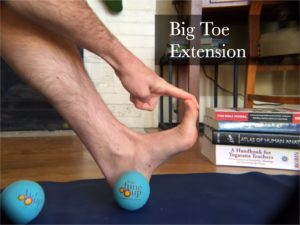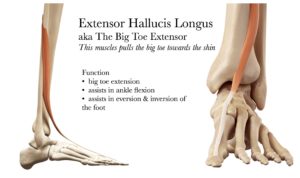
trans: The Big Deal of the Big Toe Extensor

How often do you really consider the role of your big toe in daily living? Probably more often than you think of the one muscle that is responsible for lifting the big toe to your nose: the extensor hallucis longus. We’ll just short-cut the Latin to EHL for ease of reading.

Let’s go a little more apocalyptic with our scenario. What follows is but only one of the infinite possible “hair to heel” disasters. I will heroically place myself at the center of this “Hallux Armageddon.” Hallux is fancy for Big Toe, by the way.
Once upon a time I lost extension of my big toe. My loss was accompanied by a gain: a new and unimproved gait (fancy for walking pattern.) My foot turned slightly out when I walked. At first it was no big deal. However, I had gone from pushing straight off the midline towards pushing off the inside of my foot, which translated to a shearing force across my knee joint. Owie. My body compensated, increasing the external rotation of my hip. My knee was happy but my sacroiliac joint was not. It was compressed in a bad way. So my pelvis tilted back not realizing that the tower of power that is my spine was going to collapse and cause mass hysteria in my central nervous system. The collapse happens. My ribcage crashes forward into my abdominal cavity. My autonomic nervous system, not to be outdone, switches into fight or flight mode and I feel pretty tense, you know? And I notice my neck is sticking out ahead of my entire body like I’m Myrtle the Turtle. And woe betide, my severely shortened stride I can barely extend my hip back when I walk. All of this is due to one muscle and one muscle only: the extensor hallucis longus.
And we didn’t even talk about what happened to my beautifully toned and sculpted butt. But that wouldn’t be fit for print. Glute amnesia is all I’ll say about that (because that’ll be a future blog post.)
That may sound like an exaggeration and, in fact, it is. For one, losing full use of the extensor hallucis longus (the EHL) is a rare occurrence. But decreasing the range of motion – the degree to which we can pull or move the toe towards the shin – this is all too common. And the bad news is that it doesn’t take much range-loss to create what Tom Myers calls a “low velocity, high impact” incident. And this is something to which we are all susceptible.
But don’t fret, Reader. There is hope. Tune in later this week for a little bit more drama as well as some relief. Same Yoga Tune Up® time. Same Yoga Tune Up® channel! But in the mean time, enjoy this Toe Separation Video.
Enjoyed this article? Read Ankles and Toes – Friends or Foes?











I have arthritis in my toes, so this article was very helpful to give me an understanding about the importance of moving them.
I had surgery to correct a bone spur on the MTJ and “while in there” the surgeon lengthened my EHL and E?B tendons. This was NOT in the game plan. Well, three minutes before going into the OR it was mentioned to do the extending. Had no chance to consider the ramifications. The suture failed. I had no split and only a flip-flip “surgical shoe” first four days out of OR. Then given a boot. Now the surgery will be a re-do…I didn’t realize the critical aspects of the big toe tendons. The DRs played them down and NEVER mentioned the ramifications of failure of tendon suture. THANKs for this article. Amazing how important the EHL is! Curiously the DR refuses to put a splint on the toe when we have a re-do!! Long of the short of it is, my tendons were fine and the Dr has fu$*.$* them up. I have yet to get a clear answer as to WHY they had to be lengthened in the first place.
As a student with a curiosity about the big toe (thanks to my bunions), I will continue to seek out information that might benefit this plight.
Really enjoyed reading this well written and informative article! I have several clients with issues in the feet. One an older and retired dancer who is permanently in ankle extension and has very little control through the EHL; dorsiflexion is extremely challenging and painful in her shin. While I have another client with the exact opposite problem and cannot plantarflex his foot and also has very little if any control in his toes or ROM in his toes. I am going to try this toe exercise with both and see if it creates any change. Thanks!!
You are such an entertaining writer! Loved reading your posts. That scenario struck a chord with me. I realized about a year ago that when I ran, I was landing with a slight eversion to my ankle, and felt like I was avoiding pushing off of my big toe – or to be more technical, not using my Extensor Hallucis Longus. I wondered just how long I had been doing that for! A bit scary to realize honestly. I have since then been rolling out my feet with the YTU balls and have found some relief, but I’m hoping these other exercises get me to a point where I no longer have to consciously think about pushing off of my big toe and using that EHL. Thank you for posting so I could make a connection to what I’ve been doing and now have some ways to address it!
After many years with knee issues, I read an article about the importance of foot mechanics as well as shoes that allow the foot, especially the toes, to not be cramped into tight shoes. I wish I had this knowledge thirty years ago. I believe my knees would be functioning better with less injuries, if I was aware how important our toes are. I’m working on them now. Thanks for the great article.
who would have thought, such a small limb can play such a huge role on our everyday movement!
It’s amazing what our little piggies can do for us. Thanks for the article
Enjoy the experiment of the dorsiflex-flexion with and without moving the big toe ( translate as extensor hallucinations longus). Can’t wait to read the glute amnesia article
I’m going to have my students try walking “without” the big toe. I’ve been working with them lately on the toe separation exercise. Your article provides great “context” for making this exercise mean something in real life. I had a ballet teacher who actually had had his little toes removed. Didn’t stop him from a lifelong successful career as a dancer! Would never have happened, though, if it had been his big toe! Thanks.
Biggus Dealius: Extensor Hallucis Longus
It continually blows my mind how important the big toe is to high quality gait movement. It seems a great example of how everything is connected in the body, is the big toe. I similarly noticed a while ago that one of my toes was getting tighter along with a hip bone. After some mobilizations and strengthening techniques (including the yoga tune- up moves) another thing that helped was spending more time with barefeet on different services. I started slowly, walking on grass for short distances but eventually moved to full on hiking in my bare feet and I have to say nothing seemed to get my glutes and legs firing as letting my toes free!
Loved your article. Very instructive and entertaining! I haven’t really studied the EHL yet, so I learned a lot, specially about the connection between the big toe and the ankle. Now, I knot to know more about it! Thank you for making me get curious about toes!
Entertaining and informative. Who knew the big toe, and EHL malfunction, could potentially cause such a chain reaction?! Great article, thank you!
It is amazing to me that something as small as lifting the big toe can cause so many issue else where in the body. When we are in pain we tend to focus mostly on the area that is hurting instead of looking above and below for the potential culprit. Great article and reminder to spend a little time on self careand working through blind spots daily.
Thanks Chadd for this “fun-to-read” article! I have to admit that I’m pretty blown away by the exercises you described and the effect it has. I never knew the impact a big toe can have on a body and on movement.
Really fun post Chadd. It is mind boggling how much your big toe propels you forward when you take the time to walk mindfully.
I really enjoyed this blog post. Your apocalyptic big toe scenario is probably all too real for many people. Thanks for the reminder to give the mighty EHL more attention.
Highly instructional and funny! Thanks Chad. This is fascinating. I do have friends that have lost toe mobility (or the whole toe) due to freezing. I can’t wait to hang out with them again and analyze their gait and posture (and their butts)!
One of the things I love most about Yoga Tune Up is that we dig deep into the nitty gritty and discover little muscles we never knew or thought much about. I am captivated by the chain of reactions that followed throughout the rest of your body. It’s so important, too, to remember that pain is not always what we think it is. Someone with knee pain might think “I have bad knees,” but really, they could have a weak EHL, or tight hamstrings, etc. The body awareness that comes with practicing Tune Up Poses and Therapy Ball Sequences is astounding and I feel grateful to have discovered such an important tool.
Thank you for sharing your experience, it has given me a lot to think about!
This post was dope! Doubly dope for Chadd with 2 d’s!
Toes are a funny thing aren’t they? In a lot of the work in acroyoga, there are very good reasons for the ankle to be flexed or pointed or flointed, and I’ve spent a lot of time trying to activate those good spaces, and then my toes spaz out. Or vice versa, when a teacher instructs me to isolate movement in my toes and I just have zero motor control! I could never do the spock thing with my fingers either.
Point being,
I suppose I’ve never really felt it was worth my time and effort to re-invigorate these muscles that isolate my digits, but after this blog post, maybe I’ll start taking it a lot more seriously….For what it’s worth, I flex and extend the heck out of my toes and ankles, so all the flexibility in the world is there without pain. But control, Chadd, I don’t got none!
We talked briefly about the importance of EHL today in training. This blog post just made me smarter (and giggle). I am sure this little muscle is going to come up again and again as our baby-boomer population ages and has the time to re-discover many of their favourite activities, possibly finding some shortcomings (pardon the pun) in relation to movement of the lower limb, especially if working at a desk &/or commuting regularly.
Thank you for your blog. After practicing the foot movement and trying not to use my big toe I realized how much we utilize our big toe. I also watched the toe separation video and then practiced it. I found it interesting that I could easily flex my big toe and separate the others and more difficult to solely extend my big toes.
Great article! It was very entertaining to read as well as informative! I have “gluteal amnesia” on my right hip and can clearly see the difference in motor control over my left and right big toes! I don’t know which came first, but the the corrective exercises for my gluteals are not only improving my hip pain, but over the last few months that I’ve been doing them, I can see subtle improvement in my motor control over my right big toe! There is very likely a connection!
Loved your article, style of writing (still smiling) and very informative. I had to resort to the manual manipulation of the toes no matter how much my brain willed my toes to move. I have that disconnect quite often as well with my brain and mouth. On a side note, my dad walked, sat, slept with a permenant extension on his big toe on his right foot. His reasoning was a very large deep calus at the transverse arch area of that foot due to wearing his army boots in the Korean War. It became his trademark when my mom had to identify him by only his feet as he stood behind a curtain (a party game).
This is where the exercise Jill Miller has created called “Sitting Seza” can help in addition to the Dandasana Inversion/Eversion routine posted above. Sitting Seza will promote articulation at the metatarsophalangeal joints as well as the interphalangeal joints. One of my favorite ways to exercise my feet is to going walking in the sand at the beach as well as rolling out the plantar fascia with YTU balls or Melt Method Balls. Our current U.S. population should be so grateful for these tools and techniques to keep our bodies in motion!
“Can you lift your big toe? Quote was the first question the palliative care doctor asked my mother. Be able to lift the big toe is one of the biggest concern for fall prevention. It’s great to have a couple tools like Toe Separation to help people out with this one waning strength.
WOW! What an amazing reminder or how our “little” muscles play a HUGE role in the body. I would have never thought that by not pushing off one toe the right way could effect the health of the knee joint. We did this exercise today in the level 1 tune up training and I was SHOCKED by how hard it is…needless to say it is something I will need to incorporate into my weekly routine!
We did this exercise in level 1 YTU class and it isn’t easy! I think my toes have been away from my brain too long! When we were baby’s, they were in our mouth. This is an invaluable practise for me as I had had broken toes and a broken ankle. Rolling the feet and soleus muscles help to bring movement into the toes and feet.
The knock on effect of simply having a ‘lazy’ big toe and inactive extensor hallucis longus – its impact on poor gait, external rotation of the hip, collapse of the spine and ANS. Nice reminder of the interconnection.
The extensor hallucis longus is an important muscle for going and climbing stairs. But for good placement and alignment are the peroneus longus and the tibilais posterior more important. They place the big toe knockle on the floor and building the ” impulse centrum” for going. To prevent malposition like ” Hallux valgus”.
This is one of my favorite articles!! Such a small muscle, controlling a small limb/joint, BUT can change everything up the chain! Your Armageddon analogy is perfect and fits many things that go wrong in our body. Pay attention to the small things folks!!
Chad, great, articulate blog. There is not nearly enough appreciation for the work for our big toes. As I start to notice more people’s feet, the big toe’s range seems to disappear with age for too many folks. Thankfully, there is hope with a little commitment on their part. And we know their balance with be grateful!!
Excellent information. We definitely don’t pay near enough attention to our feet! Probably because they don’t change much over time, especially size-wise. Yet, they are at the root of many problems. When you stop and think about how much we put them through and how little time we actually spend working on them, it all makes sense.
OMG this was fun and enlightening. i have students who when sitting in Vajrasana with flexed feet, their toes don’t bend. ah ha I now want to ask them to walk and observe what happens & how they do!
Wonderful article, it’s amazing how the big toe can affect the sacroiliac joint!
Thanks be to Chad! This was so much fun to read. Both my big toes and I are grateful for the “pick-me-up”
I don’t see the toe separation video; pls send link, thanks
Great article! I loved all of the visualizations!